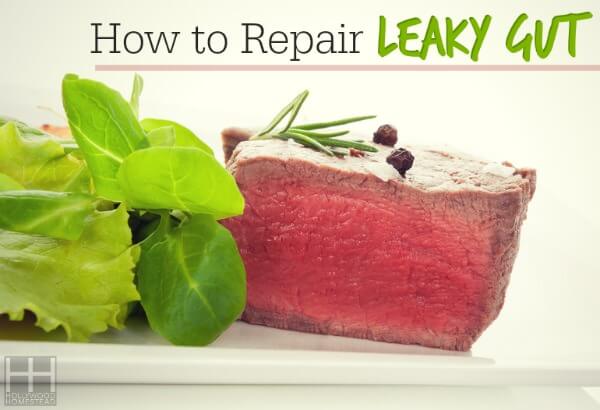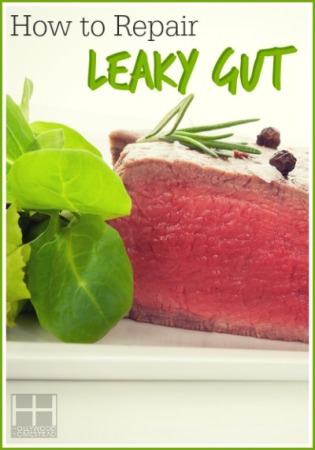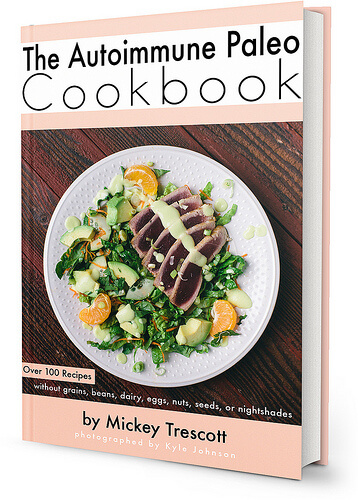
Your gut is connected to all parts of your body, so having a leaky gut can take a toll on your entire health.
The most obvious symptoms are gastrointestinal, like bloating and gas, but you can also experience problems like weight gain, malnutrition, depression, and fatigue – and this is all before leaky gut syndrome causes a full-blown autoimmune disease!
It is imperative that you repair leaky gut syndrome to save your health and wellbeing. With the right steps, you can repair leaky gut, get rid of symptoms, and even reverse autoimmune disease.
Learn more about what leaky gut syndrome is here and how to diagnose leaky gut syndrome.
UPDATE: Good news! There is now a leaky gut diagnosis test that you can order directly without a doctor’s order! While I’m a HUGE fan of having a doctor’s guidance, I understand the need to know whether you have leaky gut or not before you invest in a practitioner. You can order the test directly here.
Step 1: Eliminate Foods Which Damage Your Gut
If you haven’t already done so, the first order of business would be to eliminate the foods (or worse, foodstuff ) that damaged your gut. Eating real foods of the highest quality you can afford is the best place to start for both prevention and treatment.
By “real foods”, I mean food with ingredients that you could find in nature.
So, none of those processed junk foods with their scientific-sounding, unpronounceable names and mass quantities of refined sugars. These foods wreak havoc on your gut, causing inflammation and upsetting the balance of your gut flora.
You’ll also need to avoid foods which cause inflammation or upset the gut in other ways. This means avoiding grains. Yes, even “healthy” whole grains and also legumes (that includes peanuts).
Grains and legumes are difficult to break down. They also contain chemicals like phytates which block nutrient absorption. Further, they crowd out room on your plate for more nutrient dense foods such like as pasture-raised meat and vegetables.
I would also avoid consuming large quantities of nuts as you are trying to heal your gut since they are also difficult to break down, and the goal is to make it as easy on our guts as possible, especially during this repair phase.
Nuts that are soaked and dehydrated are a bit easier to digest but I would suggest avoiding them altogether or at least keeping them to a minimum until you get some repair underway. Instead, focus on all kinds of meat (preferably pastured or wild caught) and plenty of vegetables and some fruit (preferably organic).
This elimination diet is known as the Paleo Autoimmune Protocol (AIP). It might sound super restrictive at first, but I promise you that AIP is completely doable and you can still enjoy good foods.
One resource which really helped me when I went on AIP was the Autoimmune Paleo Cookbook. The first half of the book is all about how to do an elimination diet and AIP. The second half gives you 110 great recipes free of inflammatory, gut-harming foods.
Step 2: Improve Gut Flora with Probiotics
You’ll want to make sure you are consuming probiotics to provide your body with healthy gut bacteria. Kombucha is by far my favorite probiotic (learn more about how to brew your own kombucha here), but you can also look for or make your own lacto-fermented pickles, pickled carrots, sauerkraut, beets, or many other vegetables.
Lacto-fermentation is the real way to make pickles, not like those ones you usually find in stores which are just soaked in vinegar. Real pickles will always be in the refrigerated section.
In the United States, Bubbies is a good brand for fermented pickles and sauerkraut and you should be able to find them at your local grocery store. There are also other great brands popping up every day. Just check to make sure the ingredients say only vegetable + salt. That’s it. No funny business.
Step 3: Consume Real Gelatin
It turns out gelatin is one of the best foods you can eat for your gut. I like to think of it as spackle to fill in holes in the gut lining. No wonder bone broth, with its high amounts of gelatin, is considered the go-to remedy for any digestive problem! (Source)
Aside from calming and repairing the digestive tract, gelatin can also help gut health by increasing the amount of gastric acids which are secreted.
Wait, more acid?
You suffer from reflux?
Well, it might blow your mind to know that acid reflux is actually caused by not having enough acid as opposed to having too much (oh, and those antacids are not doing you any favors).
Our guts need gastric acid in order to adequately break down proteins. When proteins are properly digested, they won’t irritate the gut lining nor will we need to worry about big, undigested particles getting through the gut into our bloodstream. If you suffer from heartburn and want a way out, I suggest reading The 30 Day Heartburn Solution.
Gelatin also happens to have loads of other benefits, ranging from reducing wrinkles to making your joints super slippery. I love gelatin so much that I even wrote an entire book on its benefits. To learn more about gelatin and get lots of gelatin recipes, download The Gelatin Secret.
Step 4: Manage Stress
Lifestyle is also key for preventing and repairing damage to your body. Acute (once in a while) stress is unavoidable, but the chronic (constant) stress we endure these days is very damaging to our body and hinders our efforts to repair it.
Incorporating stress management techniques, sleeping at least 8 hours in a dark room and going to bed on time, meditating and taking steps to reduce stress in our day to day life is incredibly important. If your life is a ball of stress, don’t panic, just take 1 step at a time to create a life that is conducive to improving and maintaining your health.
Step 5: Reintroduce AIP Foods
Don’t worry — you don’t have to be on a super-strict elimination diet forever. After your symptoms have gone away and your gut has had some time to heal (after at least 30 days but a couple months might be better if your gut is seriously damaged), you can start to reintroduce some AIP foods back into your diet.
You must reintroduce them ONE AT A TIME.
This is how you can pinpoint which foods are causing you the worst trouble and which ones are okay to eat. It might not be the best idea to eat these foods at all, but knowing which of them your body can tolerate will give you more flexibility when eating out. How do you know which foods to introduce and when? The book The Paleo Approach is basically the AIP bible and gives you very clear explanations of how to succeed on the AIP diet.
Be Patient!
Repairing leaky gut syndrome takes time and won’t happen overnight. It took years to damage your gut so it would be unreasonable to think that it could repair in a couple of months.
Keeping a journal might be helpful as a way of tracking your symptoms and progress. Sometimes it’s hard to notice the improvements since they are so gradual but, even if you jot down once a week, you’ll have something to look back on and it can be pretty enlightening and encouraging when you look back at several weeks earlier and notice how far you’ve come since then.
Learn more about leaky gut syndrome in our posts about:
Want to learn more about leaky gut from the experts? Sign up for the FREE Leaky Gut Webinar. Presented by Jordan Reasoner & Steven Wright of SolvingLeakyGut.com and authors of the book “Surviving to Thriving”, you will learn everything you need to know about how to fight this disease. Sign Up for the Free Webinar Here.

Latest posts by Sylvie McCracken (see all)
- Treating H. Pylori (Part 3): What H. Pylori Does to the Body - August 8, 2022
- Treating H. Pylori (Part 2): How H. Pylori is Contracted - August 3, 2022
- Understanding Beef Labels: Organic, Pastured, Grass-Fed & Grain-Finished - July 25, 2022
